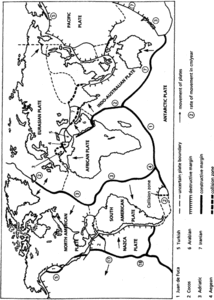A flat perforated horizontal sheet of metal used in distillation and absorption columns designed to provide an intimate contact between a rising vapour or gas and a liquid to allow vapour–liquid equilibrium to be achieved. The plate lies across the entire cross section of the column and has perforations or small openings that allow the vapour or gas to pass yet allow the liquid to remain on the plate. A variety of designs of plates are commonly used and include sieve plates, valve trays, and bubble caps. A distillation column may typically have many plates. See pass partition plate.
1. US term for anode.
2. An electrode in an electrolytic cell or in a capacitor.
1. A segment of the lithosphere, which has little volcanic or seismic activity but is bounded by almost continuous belts (known as plate margins) of earthquakes and, in most cases, by volcanic activity and young subsea or subaerial mountain chains. Most Earth scientists consider there are currently seven large, major plates (the African, Antarctic, Eurasian, Indo-Australian or Indian, North American, Pacific, and South American Plates). There are also several smaller plates (e.g. the Arabian, Caribbean, Cocos, Nazca, and Philippine Plates) and an increasingly long list of microplates (e.g. the Gorda, Hellenic, and Juan de Fuca Plates). The positions of the boundaries of some present-day plates are disputed, particularly within and adjacent to collision zones, e.g. the Alpine–Himalayan belt, so it is not surprising that very little agreement has been reached about the histories of plates in the geologic past.
2. A general term applied to plane pieces of skeletal material usually formed from calcium carbonate. Plates occur in groups of several types, e.g. the delthyrium in some brachiopods (Brachiopoda) is closed by a pair of deltidial plates.
3. The outer covering of a crinoid (Crinoidea) body, which consists of a series of rows of plates.
4. The bony covering, often fused to the ribs, on the upper and lower surfaces of the body of a turtle. The upper surface is the ‘carapace’, the lower is the ‘plastron’.
A rigid segment of the Earth’s crust which can ‘float’ across the heavier, semi-molten rock below. The plates making up the continents—continental plates—are less dense but, at up to 35 km deep, are thicker than those making up the oceans—the oceanic plates—which are up to 5 km deep. A plate is a part of the lithosphere which moves over the plastic asthenosphere. The boundary of a plate may be a constructive, destructive, conservative, or, more rarely, a collision margin. The theory of plate tectonics submits that the Earth’s crust is made up of six large plates: the African, American, Antarctic, Eurasian, Indian, and Pacific plates, and a number of small plates, the chief of which are the Arabian, Caribbean, Cocos, Nasca, Philippine, and Scotia plates. Hansen (2007) Geol. 35, 12 postulates that the ability of a terrestrial planet to evolve plate tectonics is a function of planet size.
The movement of plates causes global changes, such as continental drift and a remodelling of ocean basins and the creation of major landforms: oceanic ridges, fold mountains, island arcs, and rift valleys, together with earthquakes and volcanoes, which occur at a destructive plate boundary where one plate plunges below another. See Cloos (1993) GSA Bull. 105, 6 on lithospheric buoyancy and subduction of oceanic plateaus, continental margins, island arcs, spreading ridges, and seamounts. Plates are driven, at least partly, by forces from the convecting mantle. Oceanic driving forces are exerted when a lithospheric plate is being carried by a faster-moving asthenosphere. Ridge-push is the gravitational sliding of a plate off a mid-ocean ridge, in response to the ridge-push force, caused by the horizontal spreading of the near-surface asthenosphere at constructive margins; see Wilson (1993) J. Geol. Soc. 150. Anderson (2001) Science 293 holds that only upper mantle convection may be driven by plate tectonics; Bokelman (2002) Geology 30, 11 finds that, in the case of the North American plate, the mantle plays an important role in driving the plates. The sinking of a cold, dense slab of oceanic plate provides a slab-pull force (see Schellart (2004) Geophys. Res. Letters 31, L07611). Conrad and Lithgow-Bertelloni (2002) Science 298 estimate the relative importance of ‘pull’ versus ‘suction’, finding that the pull from lower mantle slabs is not coupled to the surface plates. Scoppola et al. (2006) GSA Bull. 118, 1 observe that slab pull is ‘notoriously considered one order of magnitude larger than ridge push’.
Eagles et al. (2009) Tectonophysics offer an animation of the Southern convergent margins, and M. Summerfield, ed. (2000) has a collection of papers on global tectonics and macroscale landform development. N. Oreskes, ed. (2001) brings together the reminiscences of the major players in development of plate tectonics theory, and C. Ollier (2000) analyses current problems related to mountain tectonics.

Plates
- coil
- coiling
- coil loading
- coimplication
- coin
- coinage metals
- coincidence circuit
- coincidence of wants
- coincident
- co-insurance
- cointegration
- coitus
- coke
- Coke, Sir Edward (1552–1634)
- cokriging
- col
- colatitude
- Colbert, Jean Baptiste (1619–83)
- Colburn j factor
- colchicine
- cold-blooded animal
- cold boot
- cold cathode
- cold dark matter
- cold deck